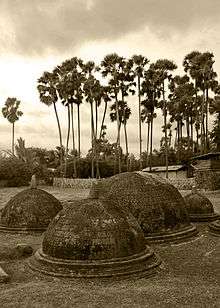Kandarodai
| Kandarodai கந்தரோடை කදුරුගොඩ | |
|---|---|
| Hamlet | |
 Kandarodai | |
| Coordinates: 9°45′0″N 80°01′0″E / 9.75000°N 80.01667°E | |
| Country | Sri Lanka |
| Province | Northern |
| District | Jaffna |
| DS Division | Valikamam South |
Kandarodai (Tamil: கந்தரோடை, Kadiramalai Tamil: கதிரமலை or Kandurugoda - literal Sinhala translation of Kadiramalai[1] Sinhalese: කදුරුගොඩ) a small hamlet and archaeological site of Chunnakam town is a suburb in Jaffna District, Sri Lanka. Known as Kadiramalai (from Kudiramalai) in the ancient period, the area served as a famous emporium city and capital of Tamil kingdoms in the Jaffna peninsula of North Eastern Ceylon from classical antiquity. Located near a world-famous port at that time, Kandarodai was the first site the Archaeology Department in Sri Lanka excavated in the Jaffna peninsula.
Black and red ware Kanterodai potsherd Tamil Brahmi scripts from 300 BCE excavated with Roman coins, early Pandyan coins, early Chera Dynasty coins from the emporium Karur punch-marked with images of the Hindu Goddess Lakshmi from 500 BCE, punch-marked coins called puranas from 6th-5th century BCE India, and copper ‘kohl’ sticks similar to those used by the Egyptians in 2000 B.C found in Uchhapannai, Kandarodai indicate active transoceanic maritime trade between ancient Jaffna Tamils and other continental kingdoms in the prehistoric period. The parallel third century BCE discoveries of Maanthai, Anaikoddai and Vallipuram detail the arrival of a megalithic culture in Jaffna long before the Buddhist-Christian era and the emergence of rudimentary settlements that continued into early historic times marked by urbanization.[2] The chief Pittan-Korran of Kudiramalai further south, a commander-in-chief of the Chera king, administered the locality under the Chera kingdom from the 1st century BCE - 1st century CE and is described at length in the Purananuru.[3]
A group of Dagobas situated close together at the site served as a monastery for Tamil monks and reflect the rise in popularity of Buddhism amongst Jaffna Tamils and the Tamils of the ancient Tamil country in the first few centuries of the common era before the revivalism of Hinduism amongst the population.[4] Recent excavations of Sivaganams in the stupas suggest Tamil Hindus also worshipped at the site. The domes were reconstructed atop the flat bases of the ruins by the Archaeology Department. The similarities between the finds of ancient Jaffna and Tamil Nadu are indicators of a continuous cultural exchange between the two regions from classical antiquity.[5] These structures built over burials demonstrate the integration of Buddhism with Megalithism, a hallmark of Tamil Buddhism. Outside Andhra Pradesh in India, Kanterodai is perhaps the only site where such burials are seen.
In 1970, the University of Pennsylvania museum team excavated a ceramic sequence remarkably similar to that of Arikamedu, with a Pre-rouletted ware period, subdivided into an earlier "Megalithic", a later "Pre-rouletted ware phase," followed by a "Rouletted ware period". Tentatively assigned to the fourth century BCE, radio carbon dating later confirmed an outer date of the ceramics and Megalithic cultural commencement in Kandarodai to 1300 BCE.[6] Further excavations have been conducted by the University of Jaffna.
The Yalpana Vaipava Malai also describes the rich port of Kadiramalai in the ancient period.
Gallery
| Kandarodai Gallery | ||||||
|---|---|---|---|---|---|---|
|
See also
References
- ↑ http://www.np.gov.lk/index.php?option=com_content&view=article&id=35&Itemid=8
- ↑ S. Krishnarajah (2004). University of Jaffna
- ↑ V. Kanakasabhai. The Tamils Eighteen Hundred Years Ago. pp.110
- ↑ Peter Schalk. Buddhism among Tamils in pre-colonial Tamilakam and Īlam: Prologue. The Pre-Pallava and the Pallava period pp. 1
- ↑ Man and environment (2002). Indian Society for Prehistoric and Quaternary Studies. Volume 27, Issue 2. pp. 27
- ↑ (Begley,V. 1973)
| Wikimedia Commons has media related to Kandarodai. |

